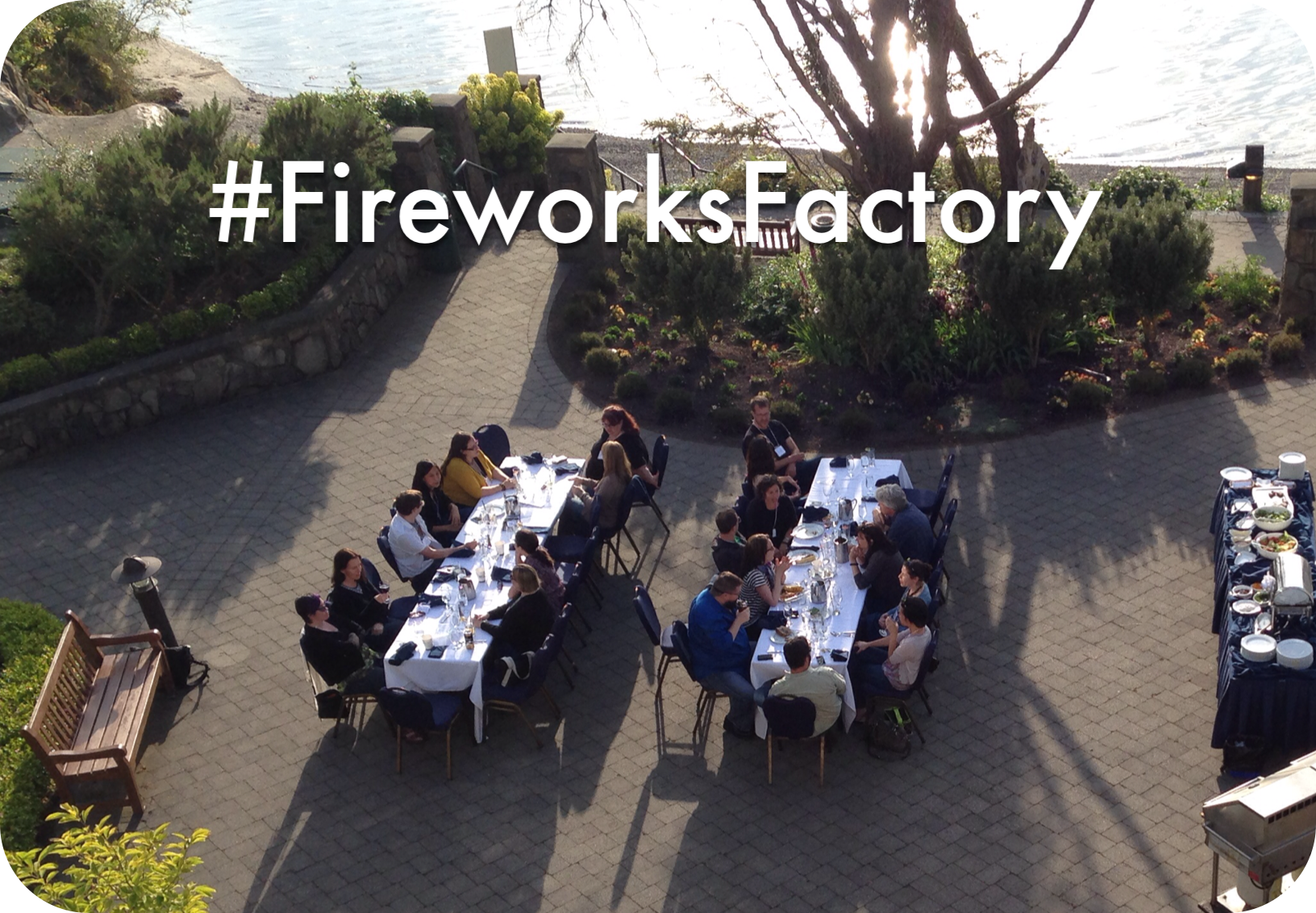Fireworks Factory is the marketing retreat of the year for Canada’s most innovative digital marketers. I spent 3 days on Pender Island with this year’s cohort of senior marketers, decision makers, strategists, experts and consultants. Each contributed something meaningful to my professional and personal development so I’d like to share some of the standout quotes from Fireworks Factory.

“Suffering is optional.” —Ken Lawson, long-time cast member and lead facilitator for Vancouver Theatresports League’s corporate training
Among the many rules for improv, Ken taught us to support each other in our communications. If your prime responsibility is to make others look good, not yourself, then they’ll do the same in return. Seems like important advice for managers, entrepreneurs, customer service, and, oh the list could go on and on.
Supporting each other (and problem solving) is also much easier when you’ve broken the ice. Ken got us to do an exercise with our tongues hanging out, and this reminded me of a fantastic point in Atul Gawande’s Checklist for Surgery Success (listen to the story on NPR).
When introductions were made before a surgery, Gawande says, the average number of complications and deaths dipped by 35%.
“Making sure everybody knew each other’s name produced what they called an activation phenomenon,” Gawande explains. “The person, having gotten a chance to voice their name, let speak in the room — were much more likely to speak up later if they saw a problem.” Good lessons for customer service, internal meetings, and other team interactions, especially when there’s unfamiliarity in among group members.
On Being Seen, And Heard
Thinking about how others see us, may also change how we see ourselves.
In particular, Amy Cuddy’s TED Talk “Your Body Language Shapes Who You Are” highlights that different postures (or open vs. closed body language) can change other people’s perceptions—and even our own body chemistry—which can have an impact on our chances for success. Totally worth watching!
But always succeeding doesn’t always make you a success.
Ken said that creativity happens when you let go of control. So make mistakes and fail. Embrace the fail as path to the gem. Stewart Butterfield, creator of Flickr and Slack, is the phoenix who comes to mind given that those successful projects came out of the ashes of failed projects.
Picking the winners can be hard, but when it comes to timing for promotional opportunities, Cameron Uganec, director of marketing at Hootsuite, had some good advice.
He said, and I’m taking great liberties in my summary, that every company is trying to pimp a ride on the coat tails of the major holidays. Given the noise around holidays like Thanksgiving, Christmas, New Year’s and Valentine’s Day, look for the lesser yet still notable holidays like Secretary Appreciation Day or the birthday of a historical figure. The key is to find a connection to something with existing media attention, but that you can own.
Foresaking quantity for quality also came up in a case study shared by Laura Authier, director of marketing and communications at St. Michaels University School. When the stakes are high, for example winning a year’s tuition to SMU, then the quality of the entries is also going to be very high. Given the buy in, contribution and commitment taken on by the entrants, the shortlisting and winner process must be mindful of the people and emotions involved.
Nobody likes disappointment. And Adam Mordecai, founding curator and editor-at-large at Upworthy, offered a great piece of advice about the type of content that gets shared online.
He said that Moms are the biggest sharers, and since no one likes to disappoint their mom, they are unlikely to share content that might offend mom. Good point to keep in mind when crafting messages, especially for Facebook.
Speaking of crafting messages, spoken word artist Shane Koyczan, blew me away in one of the evening sessions. To This Day Project is an example of Shane’s amazing work collaborations.
More Great Advice
On personas, behaviour and motivations
- Marketing Personas: Lots of people go into backcountry, that alone doesn’t form the basis for a persona. Build the persona based on the primary motivation behind why they go into the backcountry: want nature, want to be with friends, want exercise. Personas built around motivations vs. age or task are more effective tools.
- The girl who invented the flashlight that doesn’t need batteries entered the Google science fair with 1 hour left. Contest entries that have a high-level of detail will garner high-quality entries, but they’ll come late in the game.
- Upworthy’s metric Attention Minutes trump pageviews or time on site or any single metric. Single metrics never tell the full story, which I emphasized in my Ignite presentation, “The Quantified Newborn: There’s an app for that.”
On communication and storytelling
- When explaining, find the balance between how much detail you provide on “why” vs “how”. Answer: “why should I care” and then “how do I do it.” Lee LeFever’s Art of Explanation talks about the A-Z scale. Consider where the audience is on the scale and how far you need to move them. It might be from G to V vs. A to Z.
- One of my favourite quotes is from Adam Mordecai in regards to email or texts going off the rails. “Escalate the medium, not the tone.”
- Another quote to live by: “If you do in life what’s hard then life gets easy. If you do in life what’s easy then life gets hard.” Thanks to Megan MacMillan, Communications for West Point Grey Academy.
- Crafting messages: You need a hero, villian, emotional story arch, showmanship (Read Winning the Story Wars) … Note: The villian can’t be evil or a baffoon. Which reminds me: This UX Designer’s client documents that are done as comic books. Even the “bad guys” make rational decisions. Don’t make them stupid. Also don’t make the “bad guy” a superarch villian, otherwise they seem undefeatable.
- Problem solving the improv way: Say “Yes And” vs. “Yes But.” Both can be useful conversation tactics. Make sure you mindfully choose your approach, especially if you’re usually a naysayer.
- Break the routine.
- “Be the show, not the commercial.” —Cameron Uganec of Hootsuite
On crafting share-worthy content
- People don’t want to feel stupid. They won’t share a post if they don’t get the reference. For example, be mindful of name dropping. Test headlines and copy with the name vs. “This Model” or “This Celebrity”, etc.
- When things are presented as facts, people stick to their guns because admitting that they are wrong about this one thing means they must think about all the other things they believe to be true.
- Framing is #1. How you frame a story can push it forward or hold it back. A great example from Upworthy:
This Amazing Kid Got to Enjoy 19 Awesome Years on This Plant. What He Left Behind Is Wondtacular.
Zach Sobiech, at the age of 14, found out he had a rare form of terminal cancer. So he became a rock star, and millions of people got to see his music before he passed away on May 20, 2013.
“You don’t have to find out you’re dying to start living.”
Or as Ken says, suffering is optional.


